38 different kinds of snakes live in South Carolina, but only six of them are venomous. The cottonmouth is arguably the most famous black snake in North America. It’s on our list of black snakes in South Carolina because it is found within the state.
Even if a snake is venomous, it’s safe to assume that it doesn’t want to attack you. In almost every situation, a snake will flee or put up a display of some sort before it resorts to biting.
Snakes are vital to the ecosystem in which they’re found. They provide natural insect and rodent control, which protects plants of all types. That’s why it’s good to know the difference between black snakes so you know which ones are dangerous and which are not.
Since South Carolina is humid and hot, it’s the perfect climate for snakes to thrive. The marshes and grasslands found throughout the state are also excellent habitats.
Let’s look at six black snakes in South Carolina so you have a better understanding of what’s out there in the state. We’ll look at some pictures and also discuss important details about each snake.
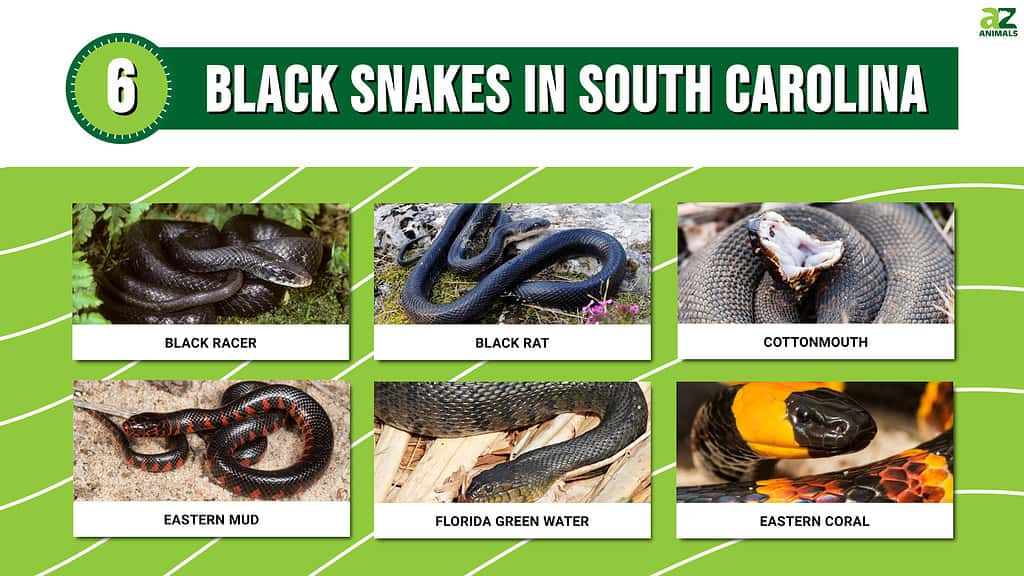
6 Black Snakes in South Carolina
1. Black Racer
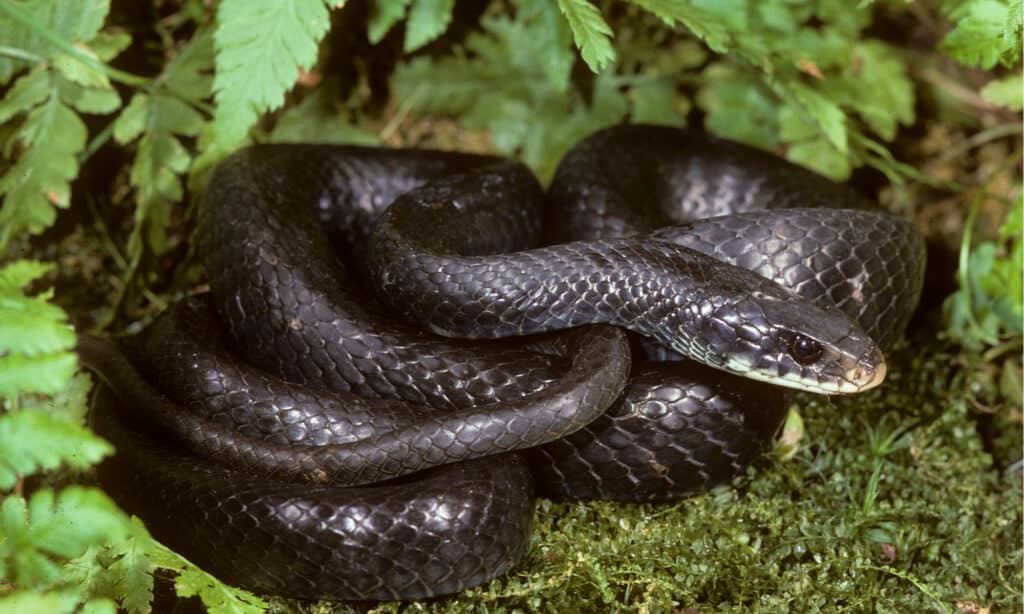
When black racers are on the move, they eat bird eggs which cause nest failure.
©Breck P. Kent/Shutterstock.com
Black racers are the most common snakes in South Carolina. These snakes are all black except for their white chins. They’re nonvenomous, so if you encounter one while on a hiking trail or gardening, let it flee.
Snakes have been attributed to an increase in wild nest failure, and black racers are no different. However, it isn’t the size of their population that determines how many nests are raided. Rather, it’s where they’re going.
Snakes that are traveling a long distance are more likely to eat nest contents. They’re fast, which is why they’re called racers. These snakes can move up to 4 mph, which is exceptional for a snake.
Black racers are opportunistic feeders and will eat anything convenient as they move around their habitat. Bird eggs and chicks are no exception. Coachwhips and corn snakes behave in the same manner.
2. Black Rat Snake
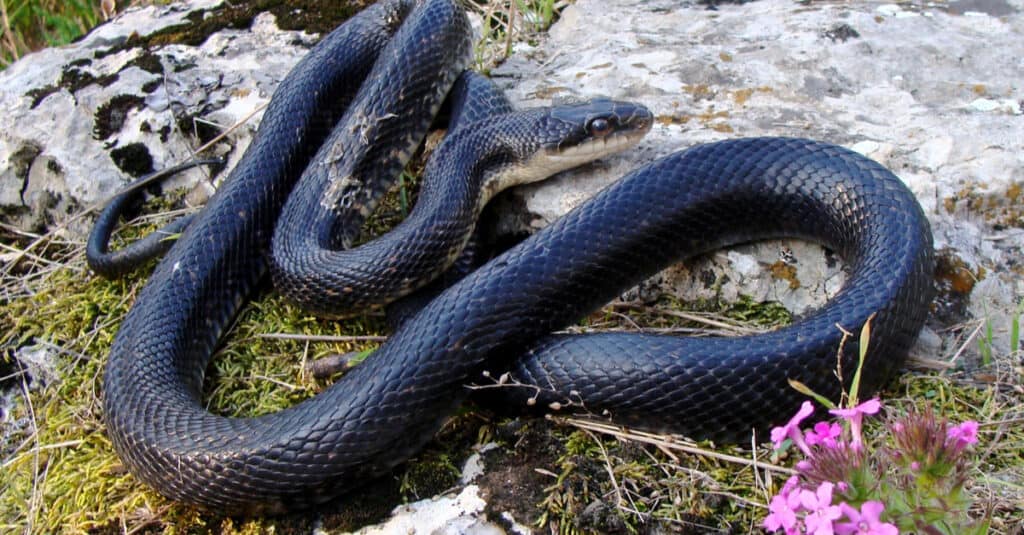
Black rat snakes are excellent climbers.
©Matt Jeppson/Shutterstock.com
Black rat snakes are often confused with black racers, but they’re distinctly different snakes. These snakes are excellent climbers. They’re also nonvenomous.
Young black rat snakes do not look like their adult counterparts. Rather, they’re lighter with blotches on their backs. These snakes are known to cause nest failure within their ranges because they actively seek bird eggs. This is especially true for birds that live in the grasslands that black rat snakes prefer.
3. Cottonmouth

Cottonmouths are venomous, but they want to flee instead of fight.
©Marcum Havens/Shutterstock.com
Cottonmouths are highly venomous. Since they like to spend most of their time in the water, they’re also known as water mocassins. Almost every one of the black snakes on our list has been mistaken for a cottonmouth at one point.
When it’s time to brumate, cottonmouths leave their aquatic surroundings and head inland. This raises important questions about what habitat conservation means. If an animal migrates through an area, should that be conserved as well?
When threatened, cottonmouths bare their white mouths. Since cotton is white, these snakes earned their name from this display. While a cottonmouth’s warning to back off may seem threatening, it wants you to leave it alone as much as you want to get away from it.
If opening their cotton white mouth doesn’t work at deterring a threat, they’ll rattle their tails against the ground and emit a disturbingly sweet yet sickly musk before they strike in defense.
Sometimes, cottonmouths have markings on them, and their bodies are a bit lighter than deep black. However, most individuals are black. If you’re in South Carolina, this is one of the most important of the black snakes that you need to keep in mind.
4. Eastern Mud Snake
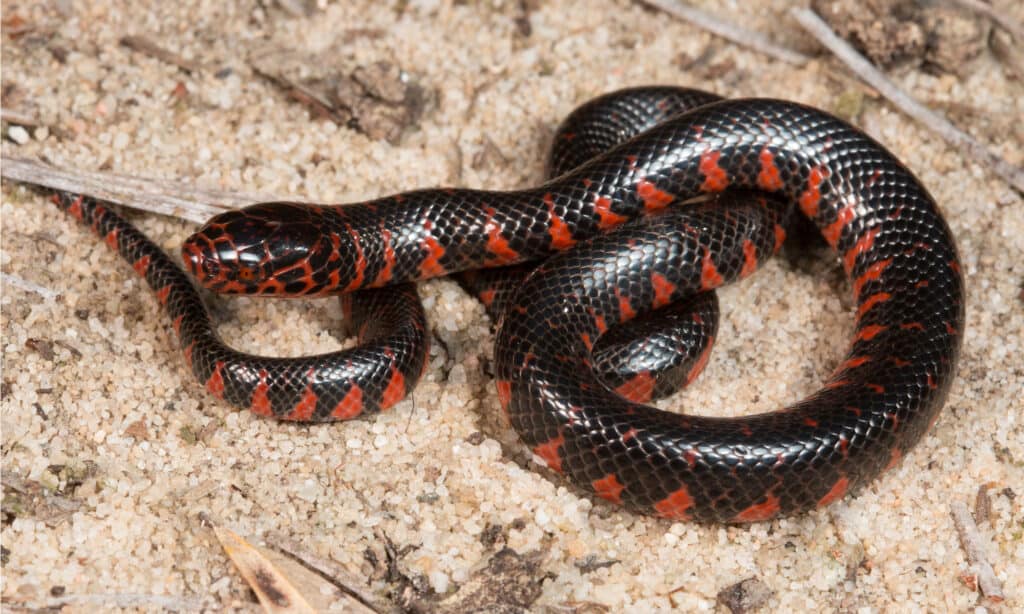
Eastern mud snakes are found in the low country of South Carolina.
©Nathan A Shepard/Shutterstock.com
Eastern mud snakes are most commonly found in the low country of South Carolina. They are huge snakes. These snakes are primarily black, but they’re among the most distinguishable of the black snakes on our list. They have bright red markings on their bodies that make them highly visible and recognizable.
5. Florida Green Water Snake
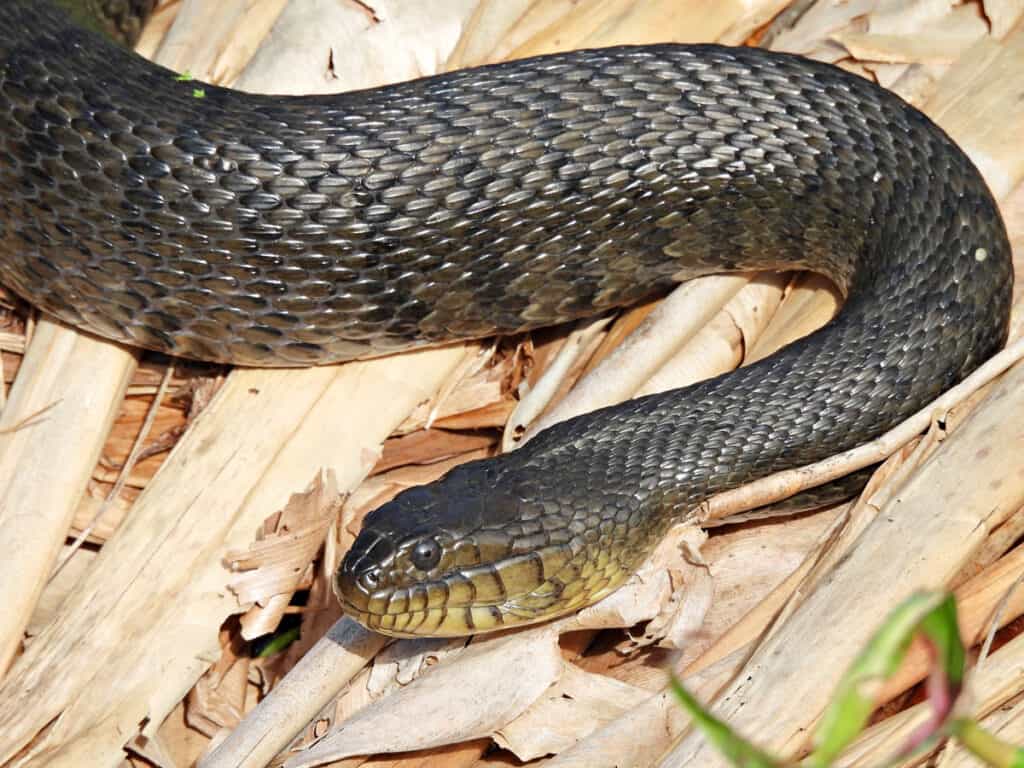
The Florida green water snake population in South Carolina is isolated from the main population in Florida.
©iStock.com/passion4nature
South Carolina plays host to snakes that are more reliably black than these snakes. However, the Florida green water snake has individuals within its population in South Carolina that appear all black. This snake is mostly aquatic and grows to be no more than six feet in length. While they are nonvenomous, they readily bite if surprised or handled.
Florida green water snakes are indiscriminate about what kind of water source they’ll live near, though they are always near water. Their favorite habitats are lakes, marshes, and ponds. Also, they prefer water that’s out in the open and lacks a canopy of vegetation or trees. They especially enjoy some aquatic plants like water shields, water lilies, and cow lilies.
The Florida green water snakes in South Carolina are a distinct and disjunct population from the Florida green water snakes in Florida. Florida and southern Georgia are the primary ranges of this species, but South Carolina has an independent group of individuals in the state.
These snakes in South Carolina may be made up of two isolated groups as well. They’re confined to the southern part of the state. They are a rare sight, and their population is declining due to swamp drainage and the destruction of wetland habitats.
6. Eastern Coral Snake
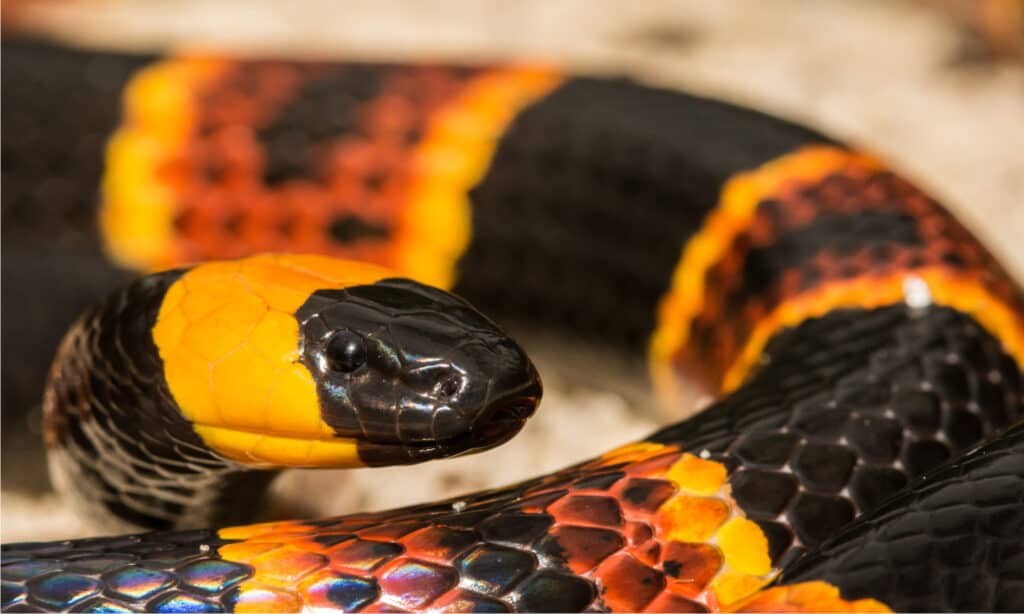
Eastern coral snakes are only found in South Carolina along the coast.
©Jay Ondreicka/Shutterstock.com
This is another easily identifiable snake in South Carolina because of its brightly colored bands. Generally, the snake’s main color is black, while the bands are bright red and framed by stripes of yellow.
Eastern coral snakes are rare around the state because they mostly stick to the coast. They like sand, which they use as a substrate to burrow. They aren’t above ground often, so spotting one isn’t a common occurrence. While these snakes are venomous, their propensity to stay buried and out of the way makes them less concerning than cottonmouths.
Other Snakes in South Carolina
Other snakes you are likely to come across in the state include:
Copperheads: These pit vipers which are known to shake their tails in imitation of rattlesnakes can be found throughout South Carolina. They can be recognized by dark hourglass markings which lighten on the insides with a speck at their centers, against a lighter red-brown background. They are sturdy in form and are capable of growing up to 37 inches.

Copperheads are known to shake their tails in imitation of
rattlesnakes
.
©Creeping Things/Shutterstock.com
Kingsnakes: There are two kinds of these snakes known for their ability to prey on their venomous relatives. The eastern kingsnake is black interspersed with narrow yellow bands and is found all over the state and indeed all over North America. On the other hand, the mole kingsnake found in the northern part of the state, is light brown with darker patches of color and has a smaller head. Unlike the eastern kingsnake which is capable of growing to four feet, the latter is capable of growing to three feet.

Eastern kingsnakes are generally larger than mole kingsnakes and can be found all over South Carolina
©iStock.com/JasonOndreicka
Summary of 6 Black Snakes in South Carolina
Here’s a recap of the six venomous black snakes present in South Carolina that we took a look at:
| Index | Snake | Location |
|---|---|---|
| 1 | Black Racer | Throughout the state |
| 2 | Black Rat Snake | South Carolina and central Georgia’s mountains and Piedmont regions |
| 3 | Cottonmouth | South Carolina’s coastal plains and sandhills |
| 4 | Eastern Mud Snake | South Carolina’s low country |
| 5 | Florida Green Water Snake | Charleston and Berkeley counties, Florida, and southern Georgia |
| 6 | Eastern coral snake | South Carolina’s coastal plain |
The photo featured at the top of this post is © Nathan A Shepard/Shutterstock.com
Discover the "Monster" Snake 5X Bigger than an Anaconda
Every day A-Z Animals sends out some of the most incredible facts in the world from our free newsletter. Want to discover the 10 most beautiful snakes in the world, a "snake island" where you're never more than 3 feet from danger, or a "monster" snake 5X larger than an anaconda? Then sign up right now and you'll start receiving our daily newsletter absolutely free.
Thank you for reading! Have some feedback for us? Contact the AZ Animals editorial team.






